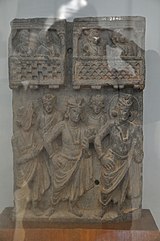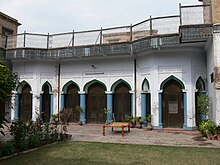Haveli

Haveli is generic term used for a traditional townhouse and mansions in India, Pakistan, Nepal and Bangladesh usually one with historical and architectural significance. The word haveli is derived from Arabic haveli, meaning "partition" or "private space" popularised under Mughal Empire and was devoid of any architectural affiliations.[1][2] Later, the word haveli came to be used as generic term for various styles of regional mansions, townhouse and temples found in India, Pakistan, Nepal and Bangladesh.[3]
History

The traditional courtyard homes in South Asia is built on the ancient principles of Vastu Shastra.[4] which state that all spaces emerge from a single point, that is the centre of the house. Courtyards are common feature in south asian architecture. The earliest archaeological evidence of courtyard homes in the region dates back to 2600–2450 BCE.[5] Traditional homes in South Asia are built around courtyard and all family activities revolved around chowk or courtyard. Additionally, the courtyard serves as a light well and an effective ventilation strategy for hot and dry climates of South Asia. During medieval period, the term Haveli was first applied in Rajputana by the Vaishnava sect to refer to their temples in Gujarat under the Mughal Empire and Rajputana kingdoms. Later, the generic term haveli eventually came to be identified with townhouse and mansions of the merchant class.[6]
Characteristic

- Socio-Cultural Aspects: The chowk or courtyard served as the centre for various ceremonies and the rituals. The sacred tulsi plant was placed here and worshipped daily to bring prosperity to the house.
- Security and Privacy: The chowk, at times, separated areas for men and women, and provided them with privacy.
- Climate: Treating open space in building design to respond to the local climate. Air movement caused by temperature differences is utilized in the natural ventilation of building.
- Different Activities At Different Times: The use of the court in the day time, mostly by women to carry out their work, interact with other women in private open space. Mansions of merchant class had more than one courtyard.
- Articulation Of Space: In Mor chowk, City Palace, Udaipur, there is the concept of courtyard as a dancing hall. Similarly, in havelis, a courtyard has several functions, commonly used for weddings and festive occasions.
- Materials : baked bricks, sandstone, marble, wood, plaster and granite are commonly used materials. Decorative aspects are influenced by local culture and traditions.
All these elements join to form an enclosure and give the chowk a composed secured feel. The architectural built form of havelis has evolved in response to the climate, lifestyle and availability of material. In hot climates where cooling is a necessity, buildings with internal courtyards were considered the most appropriate. It acted as a perfect shading technique, while also allowing light inside. The arcade along the court, or the high wall around it, kept the interiors cool.
Many of the havelis of India and Pakistan were influenced by Rajasthani architecture. They usually contain a courtyard often with a fountain in the centre. The old cities of Agra, Lucknow and Delhi in India and Lahore, Multan, Peshawar, Hyderabad in Pakistan have many fine examples of Rajasthani-style havelis.
Famous havelis in India
The term Haveli was first applied in Rajputana by the Vaishnava sect to refer to their temples in Gujarat. In the northern part of India. havelis for Lord Krishna are prevalent with huge mansion like constructions. The havelis are noted for their frescoes depicting images of gods, goddesses, animals, scenes from the British colonization, and the life stories of Lords Rama and Krishna. The music here was known as Haveli Sangeet.




Later on these temple architectures and frescoes were imitated while building huge individual mansions and now the word is popularly recognized with the mansions themselves. Between 1830 and 1930, Marwari's erected[7] buildings in their homeland, Shekhawati and Marwar. These buildings were called havelis. The Marwaris commissioned artists to paint those buildings which were heavily influenced by the Mughal architecture.
The havelis were status symbols for the Marwaris as well as homes for their extended families, providing security and comfort in seclusion from the outside world. The havelis were to be closed from all sides with one large main gate.
The typical havelis in Shekhawati consisted of two courtyards — an outer one for the men which serves as an extended threshold, and the inner one, the domain of the women. The largest havelis could have up to three or four courtyards and were two to three stories high. Most of the havelis are empty nowadays or are maintained by a watchman (typically an old man). While many others have been converted into hotels and places of tourist attraction.
The towns and villages of Shekhawati are famous for the embellished frescoes on the walls of their grandiose havelis, to the point of becoming popular tourist attractions.
The havelis in and around Jaisalmer Fort(also known as the Golden Fort), situated in Jaisalmer, Rajasthan, of which the three most impressive are Patwon Ki Haveli, Salim Singh Ki Haveli, and Nathmal-Ki Haveli, deserve special mention. These were the elaborate homes of Jaisalmer's rich merchants. The ostentatious carvings etched out in sandstone with infinite detail and then painstakingly pieced together in different patterns each more lavish than the next were commissioned to put on show the owner's status and wealth. Around Jaisalmer, they are typically carved from yellow sandstone.They are often characterized by wall paintings, frescoes, jharokhas (balconies) and archways.[8][9]
The Patwon Ji ki Haveli is the most important and the largest haveli, as it was the first erected in Jaisalmer. It is not a single haveli but a cluster of 5 small havelis. The first in the row is also the most popular, and is also known as Kothari's Patwa Haveli. The first among these was commissioned and constructed in the year 1805 by Guman Chand Patwa, then a rich trader of jewellery and fine brocades, and is the biggest and the most ostentatious. Patwa was a rich man and a renowned trader of his time and he could afford and thus order the construction of separate stories for each of his 5 sons. These were completed in the span of 50 years. All five houses were constructed in the first 60 years of the 19th century.[10] Patwon Ji Ki is renowned for its ornate wall paintings, intricate yellow sandstone-carved jharokhas (balconies), gateways and archways. Although the building itself is made from yellow sandstone, the main gateway is brown.
Famous havelis of Pakistan



There are a number of historically and architecturally significant havelis in Pakistan, most of which are situated in the Punjab province and constructed during the Mughal period.
Below is a list of some of the historically and architecturally significant havelis in Pakistan:
- Haveli Awais Meer in Walled city Lahore
- Kapoor Haveli in Peshawar
- Fakir Khana Haveli and Museum, in Lahore
- Mubarak Haveli in Lahore
- Haveli Asif Jah in Lahore
- Haveli Wajid Ali Shah in Lahore
- Choona Mandi Haveli in Lahore
- Haveli Nau Nihal Singh in Lahore
- Haveli Barood Khana in Lahore
- Lal Haveli or Chandu Di Haveli in Lahore
- Haveli Man Singh in Jhelum
- Lal Haveli in Rawalpindi
- Saad Manzil in Kamalia
- Khan Club in Peshawar
- Waziristan Haveli in Abbottabad, home of Osama bin laden
- Janjua Haveli in Malowal, Gujrat, Pakistan
- Haveli Mubashar Ali Janjua, in Matore, Kahuta, Rawalpindi
Havelis in popular culture
Haveli is also a novel by Suzanne Fisher Staples and is a sequel to her Newbery Award-winning novel Shabanu: Daughter of the Wind. The story takes place in an old-fashioned haveli in Lahore, Pakistan.
See also
References
- ^ "haveli - definition of haveli in English from the Oxford dictionary". Oxforddictionaries.com. Retrieved 2016-01-19.
- ^ Sarah, Tillotson (1998). Indian Mansions: A Social History of the Haveli. Orient longman. p. 72. ISBN 0-900891-91-2.
- ^ Bahl, Vani. "Haveli — A Symphony of Art and Architecture". The New Indian Express. Retrieved 2016-01-19.
- ^ Jagdish, Gautam (2012). Disenchanting India: Organized Rationalism and Criticism of Religion in India. abhinav publications. p. 72. Retrieved 17 August 2006.
- ^ Morris, A.E.J. (1994). History of Urban Form: Before the Industrial Revolutions (Third ed.). New York, NY: Routledge. p. 31. ISBN 978-0-582-30154-2. Retrieved 20 May 2015.
- ^ Bahl, Vani. "Haveli — A Symphony of Art and Architecture". The New Indian Express. Retrieved 2016-01-19.
- ^ "> History > Chittorgarh". Rajasthan Infoline. Retrieved 2016-01-19.
- ^ "Havelis of Jaisalmer - Havelis in Jaisalmer Rajasthan - Jaisalmer India Havelis". Rajasthan-tourism.org. Retrieved 2016-01-19.
- ^ "Jaisalmer Havelis, Famous Haveli in Rajasthan India, Heritage Haveli Tours in Rajasthan India". Shubhyatra.com. Retrieved 2016-01-19.
- ^ "Patwon Ki Haveli - Patwonji Ki Haveli Jaisalmer - Patwon Ki Haveli In Jaisalmer Rajasthan". Jaisalmer.org.uk. Retrieved 2016-01-19.
